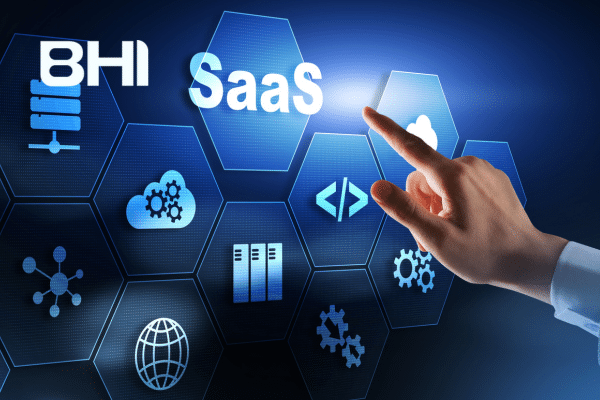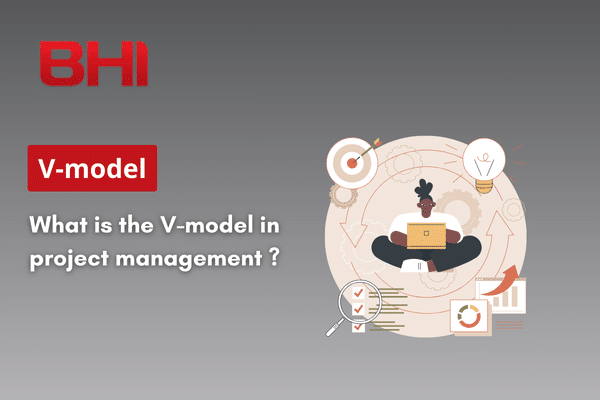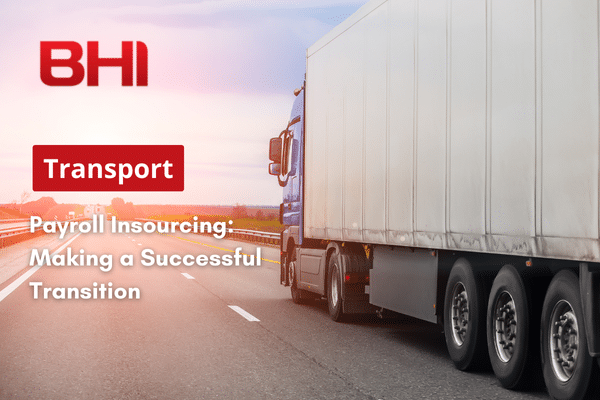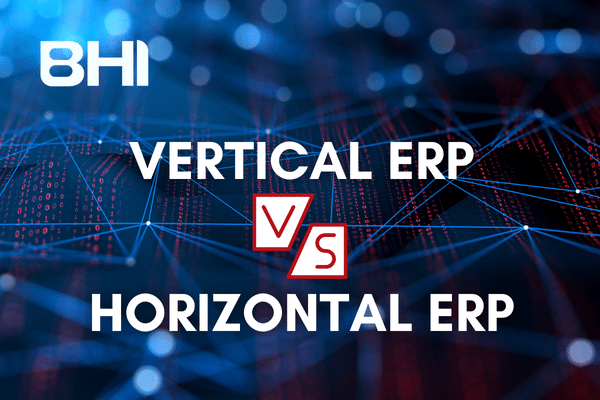SaaS ERP, also known as Cloud ERP, represents a major development in business management systems. It is a complete, integrated software solution, accessible via the Internet, that encompasses all a company’s operational processes. Unlike traditional ERP systems installed on a company’s local servers, SaaS ERP is hosted, managed and maintained by the service provider in the cloud.
This approach allows businesses of all sizes to access advanced ERP functionality without the constraints of on-premise IT infrastructure. Users can connect to the system from anywhere with an Internet connection, simply by using a web browser or a dedicated mobile application. This flexibility enables real-time collaboration and instant access to company data, regardless of employees’ geographical location.
What is SaaS ?
SaaS, an acronym for ‘Software as a Service’, is a software distribution model that has revolutionised the way businesses access and use business applications. In this model, the software is centralised and hosted on the supplier’s servers, then made available to customers via the Internet.
The main features of SaaS include
-
Accessibility
Users can access the software from anywhere, at any time, via a web browser.
-
Subscription model
Customers generally pay a monthly or annual subscription fee, rather than purchasing a perpetual licence.
-
Automatic updates
The supplier manages updates and enhancements, ensuring that all users always have the latest version.
-
Scalability
Businesses can easily increase or decrease usage as their needs change.
-
Lower IT costs
Infrastructure and maintenance are managed by the supplier, reducing the need for in-house IT resources.
The SaaS model has gained in popularity because it offers greater flexibility, reduces upfront costs and allows companies to focus on their core business rather than managing IT infrastructure.
What is ERP ?
ERP, or Enterprise Resource Planning, is an integrated software system designed to manage and optimise all an organisation’s operational processes. It acts as the company’s technological backbone, centralising data and workflows from different departments into a single, coherent database.
A typical ERP system encompasses several functional modules
- Finance and accounting
- Human resources management
- Supply chain management
- Production management
- Customer Relationship Management (CRM)
- Inventory management
- Project management
The integration of these modules enables a fluid flow of information between different departments, eliminating data silos and promoting decision-making based on real-time information. For example, a customer order can automatically update stock levels, trigger production orders and adjust financial forecasts, all in real time.
The main benefits of an ERP system include
- Improved operational efficiency
- Reduced costs through process automation and optimisation
- Better visibility of all business operations
- Faster, more informed decision-making
- Standardisation of business processes
- Improved regulatory compliance
By combining the power of ERP with the flexibility of the SaaS model, businesses can benefit from a comprehensive, accessible and scalable management solution, tailored to the challenges of the modern business world.
6 advantages of SaaS ERP over on-premise ERP
Significant cost savings
- Elimination of capital expenditure (CAPEX) on IT infrastructure
- Transformation of costs into predictable operational expenses (OPEX)
- Reduction in the cost of IT staff dedicated to maintenance
- Economies of scale thanks to shared cloud resources
Accelerated implementation
- No need to install hardware or software on site
- Simplified configuration and customisation processes
- Gradual deployment possible, module by module
- Reduced time-to-market
Greater accessibility and mobility
- 24/7 access from any Internet-connected device
- Adaptive interfaces for an optimal experience on mobile and tablet devices
- Facilitates teleworking and remote collaboration
- Real-time synchronisation of data between all users
Scalability and flexibility
- Easy adjustment of resources as the business grows
- Simple activation/deactivation of functionalities as required
- Easy integration with other cloud solutions (open APIs)
- Quickly adapt to organisational changes
Automatic, ongoing updates
- Immediate access to the latest features and enhancements
- Rapid correction of bugs and security flaws
- Reduced technical debt
- Constant compliance with the latest regulations
Enhanced security and compliance
- Security infrastructure managed by the supplier’s own experts
- Encryption of data in transit and at rest
- Compliance with international security standards (ISO 27001, SOC 2, etc.)
- Automatic back-ups and robust disaster recovery plans
What can you expect from an innovative SaaS ERP ?
A truly innovative SaaS ERP should incorporate cutting-edge technologies and offer advanced functionalities such as :
Artificial Intelligence and Machine Learning
- Intelligent process automation (RPA)
- AI-based financial and sales forecasting
- Chatbots for user and internal support
- Anomaly detection and fraud prevention
Advanced analysis and Business Intelligence
- Interactive, customisable dashboards
- Drill-down and multi-dimensional analysis capabilities
- Integration of external data sources for enriched context
- Real-time alerts based on predefined KPIs
Internet of Things (IoT)
- Integration of IoT data for predictive maintenance
- Real-time monitoring of the supply chain
- Optimised stock management thanks to connected sensors
- Improved product traceability
Blockchain
- Secure financial transactions
- Transparent supply chain traceability
- Smart contracts to automate commercial agreements
- Improved compliance and auditing
Advanced user interfaces
- Responsive design for all devices
- Conversational interfaces and voice commands
- Augmented reality for training and support in the field
- Extensive personalisation of the user experience
Open integration and APIs
- Pre-defined connectors for the main third-party applications
- RESTful APIs for easy integration with external systems
- Marketplace ecosystem for extensions and add-ons
- Low-code/no-code development capabilities for customisation
ERP in the cloud: 10 signs that it’s time to move to an innovative financial system
Current processes are slow and inefficient
- Excessive processing time for basic financial operations
- Over-reliance on manual processes and spreadsheets
- Difficulty managing seasonal peaks in activity
Lack of real-time visibility of financial data
- Inability to obtain an instant consolidated view of the financial situation
- Delays in monthly or quarterly closing
- Inability to make rapid decisions based on up-to-date data
Difficulties in generating complex reports
- Lengthy and error-prone reporting process
- Inability to produce advanced financial analyses
- Lack of flexibility in customising reports
Regulatory compliance problems
- Difficulties in adapting to frequent regulatory changes
- Increased risk of errors in tax or financial reporting
- Lack of a clear audit trail for financial transactions
Inability to adapt quickly to market changes
- Rigidity of the current system in the face of new business models
- Difficulties in integrating new entities or subsidiaries
- Slow adaptation to changes in organisational structure
High IT maintenance costs
- IT budget devoted mainly to maintenance rather than innovation
- Excessive reliance on specific and scarce technical skills
- High recurring costs for hardware and software upgrades
Lack of integration between different systems
- Data silos between departments
- Need for multiple entries of the same information
- Frequent inconsistencies between different data sources
Difficulties in supporting business growth
- Limitations of the current system in terms of transaction volume
- Inability to manage multi-entity or international operations effectively
- Lack of flexibility to add new functions or modules
User dissatisfaction with interface and functionality
- Obsolete and unintuitive user interfaces
- Lack of modern functionalities (mobility, collaboration, etc.)
- Excessive training time for new employees
Increased need for remote collaboration and mobility
- Inability to access financial data outside the office
- Lack of real-time collaboration tools
- Difficulties in managing remote approvals and workflows
This in-depth analysis highlights the significant benefits and innovations offered by modern SaaS ERP, as well as highlighting the signs that a business should consider transitioning to a cloud solution. Adopting SaaS ERP can radically transform financial operations and overall business management, providing the agility and intelligence needed to thrive in today’s digital economy.
How to deploy an ERP system in the cloud
Needs Assessment
- Perform an in-depth analysis of your company’s current business processes
- Identify weaknesses and opportunities for improvement
- Consult the various departments to understand their specific needs
- Clearly define the objectives to be achieved with the new ERP system
- Draw up a list of essential and desirable functionalities
Choice of Supplier
- Research and compare several reputable SaaS ERP providers
- Evaluate their solutions based on your identified needs
- Check suppliers’ financial stability and sustainability
- Examine customer references, particularly in your sector of activity
- Analyse the customisation and integration options on offer
- Compare total cost of ownership over the long term
Project planning
- Put together a multi-disciplinary project team
- Appoint an experienced project manager
- Draw up a detailed schedule with clear milestones
- Define the roles and responsibilities of each team member
- Identify potential risks and prepare contingency plans
- Establish a precise budget and success metrics
Data migration
- Make a complete inventory of the data to be migrated
- Clean up and standardise existing data
- Define a mapping strategy between the old and new systems
- Carry out batch migration tests to validate data integrity
- Plan a post-migration verification and correction period
User training
- Identify the different user profiles and their training needs
- Develop appropriate training materials (manuals, videos, etc.)
- Organise practical training sessions for each user group
- Set up an ongoing training and support system
- Identify and train ‘super-users’ to support their colleagues
System Testing
- Draw up a comprehensive test plan covering all functionalities
- Perform unit tests for each module
- Carry out integration tests to check interactions between modules
- Carry out load tests to assess system performance
- Involve end users in acceptance testing
- Document and correct any problems identified
Launch and support
- Carefully plan the launch date and strategy (big bang or in phases)
- Prepare a clear communication plan for all employees
- Set up a dedicated support team for the post-launch period
- Monitor system performance and user feedback closely
- Schedule regular meetings to assess adoption and resolve issues
- Establish a continuous improvement process to optimise the use of ERP
By following these detailed steps, you will considerably increase your chances of successfully deploying your Cloud ERP. Don’t forget that flexibility and communication are essential throughout the process, as adjustments will probably need to be made along the way.
Conclusion
Adopting cloud ERP represents a decisive step in the modernisation of business processes. This transition offers many benefits, from cost reduction to access to innovative technologies such as AI and advanced data analysis.
Although deploying SaaS ERP is a complex project, a methodical and structured approach, as detailed in this article, can greatly facilitate its success. Every stage, from initial assessment to post-implementation support, is crucial and requires careful attention.
It’s essential to understand that adopting a cloud ERP goes beyond a simple technological upgrade. It is a profound transformation of business processes that requires ongoing commitment to optimise its use and exploit its full potential.
Well-implemented cloud ERP can become a true catalyst for growth and innovation, providing the agility needed to thrive in today’s digital economy.
Contact us for personalised advice and to find out how we can help you implement the right solution for your specific needs. Our expertise will guide you through every step of the process, ensuring a smooth transition to a cloud ERP system that will propel your business into the future.
By investing in a successful cloud ERP deployment, your organisation is favourably positioned to meet the challenges and opportunities of an ever-changing business world.

















